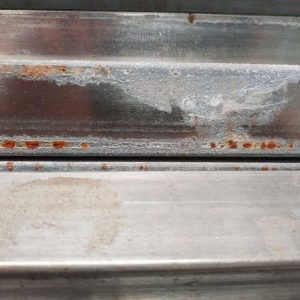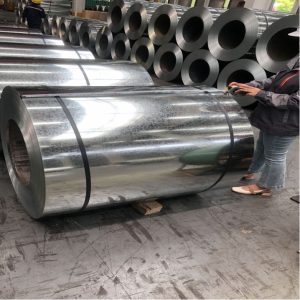19
06
2023
How to Avoid White Rust On Galvanized Steel ?
1. How to avoid white rust on galvanized steel
For their outstanding corrosion resistance, galvanized steel is widely used across a wide range of industries. White rust is a problem that galvanized sheets face. It can cause the steel to lose its integrity. Jianhui Company provides practical tips to avoid white rust and prevention measures for galvanized steel in this article. Implementing these strategies will ensure that your galvanized structures and products are durable and perform well over the long term.
2. What is galvanized White Rust?
The surface of newly coated hot-dip galvanized components will become white or gray powdery corrosion product when they are packed and stored in an environment that is humid and poorly ventilated. The corrosion product that forms on the surface of the coating is often called white rust.
3. White rust is caused by
(1) Insufficient or uneven thickness of the passivation film;
(2) Surfaces of galvanized strips are not oiled, or have residual moisture.
(3) When coiling, the surface of galvanized strip is moist.
(4) The passivation process does not dry the galvanized steel completely;
(5) The galvanized metal is exposed to rain or moisture during transport or storage.
(6) The galvanized product storage period is too long.
(7) The galvanized coils or sheets of steel are stored or in contact with other corrosive materials such as (8) acids or alkalis.


4. The galvanized white rust can have a significant impact on the steel
(1) Corrosion of galvanized surface and loss of Zinc layer: White rust causes corrosion, which leads to a loss of zinc coating. White rust, also known as zinc hydroxide, is formed when the zinc layer reacts with the water vapor present in the atmosphere. This compound will cause the zinc layer slowly to dissolve and corrode, thus destroying the integrity of the layer.
(2) Corrosion resistance is reduced: White rust can reduce the corrosion resistance. Loss of zinc exposes galvanized surfaces to corrosive environments such as air, moisture, or chemicals. This increases the risk of further corrosion.
(3) Weakening of structural integrity: White corrosion can cause galvanized steel to lose its structural integrity. The corrosion and loss of zinc can cause pits, breaks and cracks in the steel surface. This in turn reduces the stability and strength of galvanized metal, possibly reducing the load-bearing capability and safety.
(4) Aesthetic appearance is damaged: Galvanized metal is used for construction and decoration, and white rust can damage the aesthetic appeal. White rust can cause uneven spots of white rust on the surface galvanized metal, which will reduce its aesthetics and use value.
Summary: The impact of galvanized rust white on galvanized metal is primarily reflected by corrosion and zinc loss, reduced corrosion resistant, weakening structural integrity, and impaired appearance. To reduce the incidence of white rust it is important to take preventive measures such as proper storage and handling, optimizing the galvanizing process and regular inspection and maintenance on the surface of the galvanized metal.
5. White Rust Prevention
Galvanized materials need to be protected and maintained for a long time. Why it is important to prevent galvanized corrosion:
(1) Galvanized coatings offer excellent protection against corrosion. The integrity of the layer of galvanized steel can be preserved by preventing it from rusting. This will prolong the life of the steel.
(2) Maintain structural strength and stability: Rust may cause damage to the zinc layer and lead to corrosion, which can weaken the structural strength and stability of the steel. By preventing rusting of the galvanized layer, the steel is guaranteed to maintain its strength and stability during use.
(3) Reducing repair and replace costs: As soon as the galvanizing begins to rust the repair and replace cost will rise significantly. Preventing galvanized rust will reduce the need for frequent repairs and replacements, as well as saving time and money.
(4) Maintain good looks. Galvanized metal is used for construction, decoration, and other applications that require good looks. The rust can damage the surface of galvanized metal, making it look uneven. You can increase the value of galvanized metal by preventing rust.
(5) Reduce resource waste by preventing galvanized rust. Maintaining the anti-corrosion qualities of galvanized metal can increase its life expectancy, reduce the use of new materials, and promote sustainable development.
Preventing galvanized rust, in short, is very important to maintain the performance of galvanized metal, its structural stability, attractive appearance, and durability. Regular maintenance and proper precautions can extend the life of galvanized metal and preserve its quality.
6. Preventive Measures
There are many ways to prevent galvanized rust.
(1) Storage and handling: Make sure that galvanized material is stored and handled in the right conditions. Avoid moisture and rain. Also, avoid chemicals, particularly those that contain salt or acids.
(2) Choose a reliable galvanizing supplier and process. To ensure quality and consistency, make sure that the zinc coat thickness meets standard requirements and that surface preparation and cleaning is performed properly.
(3) Inspections and maintenance: Inspect the surface of galvanized materials regularly for any damage, including scratches, peeling, or abrasion. Repair and remedy any damaged zinc coating as soon as possible to prevent corrosion.
(4) Apply a protective coat: Apply a coating or paint to the surface of galvanized metal. These coatings provide an extra layer of corrosion resistance and can prolong the life span of galvanized material.
(5) Control environmental factors. Avoid exposing galvanized material to excessive moisture, heat, humidity, or corrosive conditions. Take appropriate measures based on the situation. These may include increased ventilation, protective covers or anti-corrosion coats.
These precautions can help galvanized surfaces to remain rust-free, protect their integrity, and extend their life. If galvanized materials have developed rust, remedial measures may be needed, such as cleaning, decaling, and recoating, to restore their corrosion resistance.
7. Jianhui Steel Conclusion
To prevent white rust from forming on galvanized metal, you must be proactive and adhere to best practices for the entire life of the material. Understanding the cause of white rust and taking preventive steps can help you prevent it from occurring on galvanized metal. The key factors include regular inspections, storage in the right conditions, quality control when galvanizing, and protection against environmental factors. You can maintain your galvanized metal for many years with regular maintenance.
